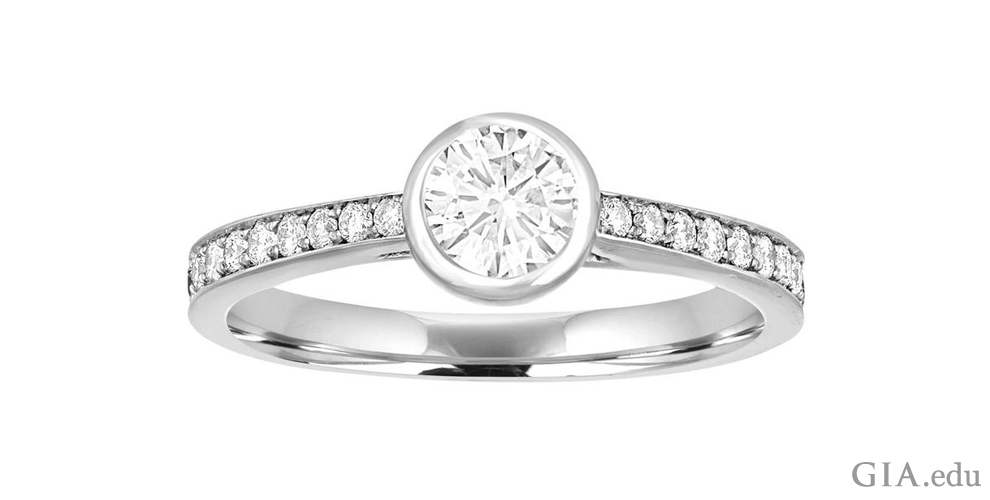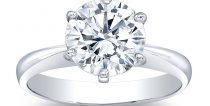Engagement ring settings should be both beautiful and practical. A setting defines your ring style, adds drama to the diamond and protects it from loss or damage. The right setting and band can also make your diamond look bigger and even more sparkling.
If you’re looking to create an illusion of size, here are some tips for engagement ring settings that can make your diamond “grow.” But first, let’s start by debunking some dubious recommendations floating around the internet.
What Doesn’t Make a Diamond Look Bigger
Diamond shape and carat weight: While a diamond’s outline – round, rectangular, oval, pear, marquise — can have some influence on the overall perception of diamond size, the shape of a diamond alone does not guarantee the stone will look bigger. The same is true for diamond carat weight. Just because one diamond weighs more than another of the same shape doesn’t mean it will look bigger. Similarly, one diamond might look bigger than another of the same shape and weight, but may be less appealing overall. That’s because there might be many factors at play, especially those related to the quality of the diamond’s cut and how its weight is distributed.
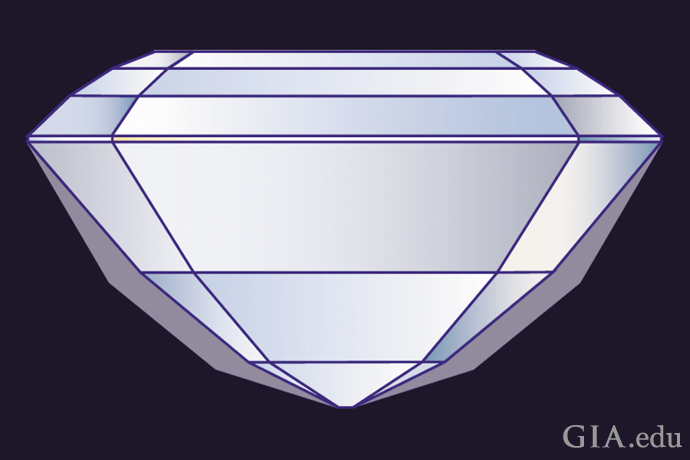
A diamond’s shape – and even its carat weight – won’t guarantee a large-looking gem. Excessive bulge, shown here by the shaded areas on either side of the pavilion, adds to a diamond’s weight without contributing to the stone’s perceived size. Illustration: Peter Johnston/GIA
Here are some examples:
- A diamond with shallow cut proportions may be physically wider and longer, but it will be far less appealing. That’s because a lot of the light that enters the crown of a shallow diamond might exit through the pavilion, making the diamond look dull and unattractive.
- A shallow pavilion depth – less than 38 percent – can create a “fish eye” effect, seen as an unattractive gray ring under the table. (Pavilion depth is measured as the distance from the bottom of the girdle plane to the culet.) As above, the diamond may be physically wider and longer, but the stone will have a dull, flat look.
What’s a crown, pavilion, girdle and culet? Learn more about diamond anatomy.
- On marquise, pear and heart shaped diamonds, the sides near the points are called wings. If they’re too flat, they make the stone look too narrow. If they’re too rounded, they make it look short and stubby.

On the left, flat wings contribute to this marquise shaped diamond looking too narrow. On the right, rounded wings contribute to this marquise shaped diamond looking stubby. Photos: Kate Waterman/GIA
White metal band: A common misconception about engagement ring settings is that a white metal band can act like a mirror to reflect and amplify a diamond’s size. The logic seems sound until you consider that a rose gold or yellow gold band could serve as a dramatic counterpoint to the diamond, making it look bigger. So a white metal band is not a foolproof solution.
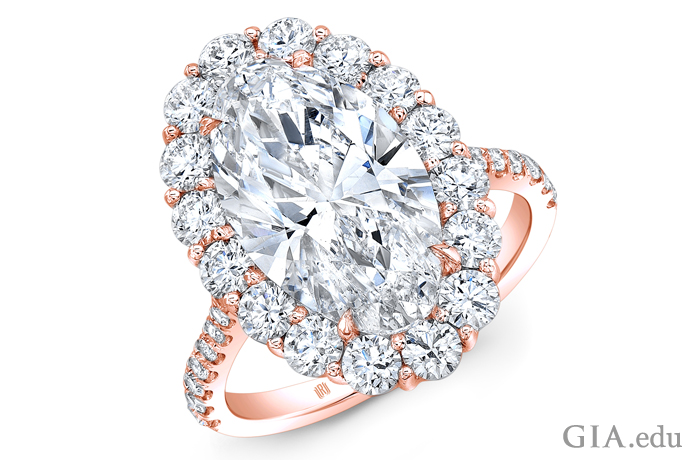
You decide if the 5.31 carats of diamonds in this ring pop because of the rose gold setting. Courtesy: Rahaminov Diamonds
Colored gemstones: Colored accent stones provide dramatic contrast to a center stone, but do they make the diamond look larger? Not necessarily. One could convincingly argue that a colored stone would compete with a diamond, thus distracting the eye.
Slender prongs: A potentially troublesome myth about engagement ring settings is that the less a prong covers a diamond, the more of the gem that’s shown, so the bigger it will look. While this may be true technically, it is not advisable. Prongs serve an essential function: they hold a diamond securely in place. Skimp on the necessary size and number of prongs, and you risk losing the diamond.
What Does Make a Diamond Look Bigger
Here are some engagement ring settings to consider if you’re looking to boost the appearance of your diamond’s size.
Illusion setting: During the Great Depression of the 1930s, when few could afford large diamonds, jewelers sometimes set a diamond in a head made of a fluted white metal. The shiny metal was made with ripples, so the whole head looked like the diamond it reflected. This setting was so successful in delivering an illusion of size that it’s still used today.
- TIP: The purpose of the illusion setting is to make a near-colorless diamond look larger, and white metal is required to achieve this particular effect. If the diamond is yellow in color, then a yellow gold illusion setting is a better choice.
- TIP: Diamonds smaller than 0.50 carat (ct) are good candidates for illusion engagement ring settings. You’d probably want to showcase a diamond 0.50 ct or larger on its own, instead of relying on the illusion setting to work its optical magic.
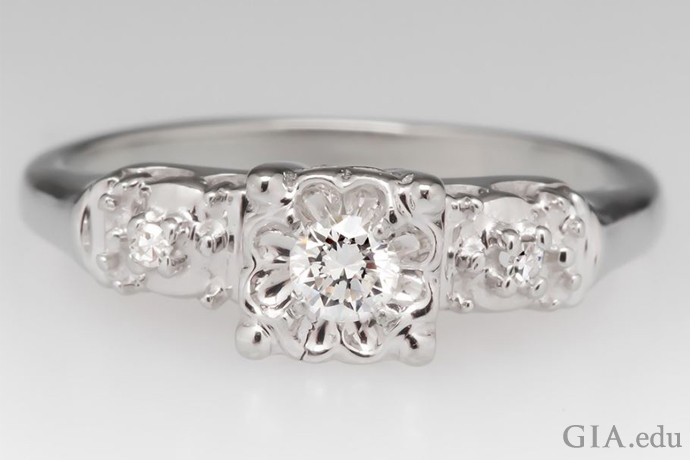
The total weight of diamonds in this ring is just 0.12 carats, but the illusion setting makes them appear much larger than they really are. Courtesy: EraGem
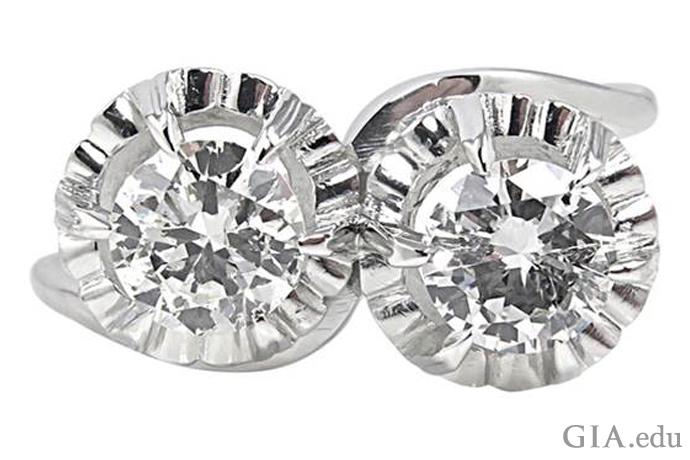
Here’s an example of a Toi et Moi (“You and Me”) engagement ring in an illusion setting. The total weight of the two diamonds is 1.18 carats, but they look larger because of the illusion setting. Courtesy: TrueFacet
Cluster setting: This engagement ring setting places several small diamonds of similar size next to each other. This technique maximizes sparkle and gives the illusion of a single diamond that is much larger in size (and more costly) than the melee diamonds used to make it.
- TIP: Diamonds of the same or similar color grades work best in a cluster setting. Diamond manufacturers know this, and match color grades when producing these kinds of rings. So you won’t have to worry about selecting the many smaller diamonds that will be part of your cluster setting.
- TIP: The more metal surrounding a stone, the more it is protected. Cluster settings have lots of metal. So your diamonds will be better safeguarded against damage.
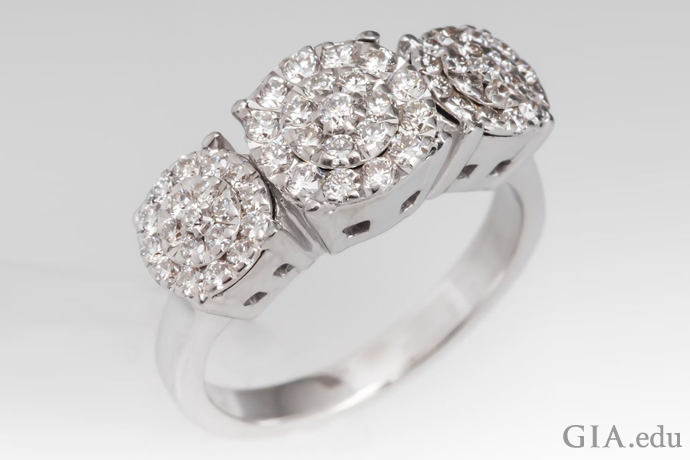
Three diamonds or 58? You might not be able to tell from a distance. In this ring, the cluster setting creates the illusion of three large gems using only 0.29 carats of diamonds. Courtesy: EraGem
Halo setting: When a ring of smaller diamonds is artfully placed around a center stone, the center stone can appear to be the size of the halo.
- TIP: Engagement ring manufacturers select the melee that makes the halo, so you won’t have to worry about picking the many small diamonds that will go into the engagement ring setting.
- TIP: A diamond center stone weighing 0.50 ct or more works best in this kind of setting because the melee in the halo will enhance it. You probably wouldn’t want to use a smaller diamond, since it would be too close in size to the melee. That combination would probably look like a pavé set ring with one diamond (the center stone) somewhat larger than the rest.
- TIP: The prongs on halo diamonds tend to wear out faster. Should you go with this style, be sure to have your ring routinely checked by your jeweler.

Where does the center stone end and the halo start? Here’s how the trick of the eye works. This double halo set with 0.50 carats of diamonds makes the 1.71 ct cushion cut center stone look even larger. Courtesy: 1stdibs.com
Pavé setting: To achieve this popular technique, many diamonds 0.20 ct or smaller are set into tapered holes in a metal surface, nestled close to the melee stones next to them. Pavé creates an appearance of uninterrupted diamonds in the band, which can make the center stone look larger.
- TIP: Pavé set diamonds in engagement ring settings are typically very secure, as the diamonds are set into metal. However, should a diamond fall out, it is more difficult for a bench jeweler to replace it.
- TIP: Avoid engagement ring settings with pavé set diamonds on the bottom of the shank. This area of the ring is exposed to a lot of friction, so the diamonds are more easily lost or damaged.
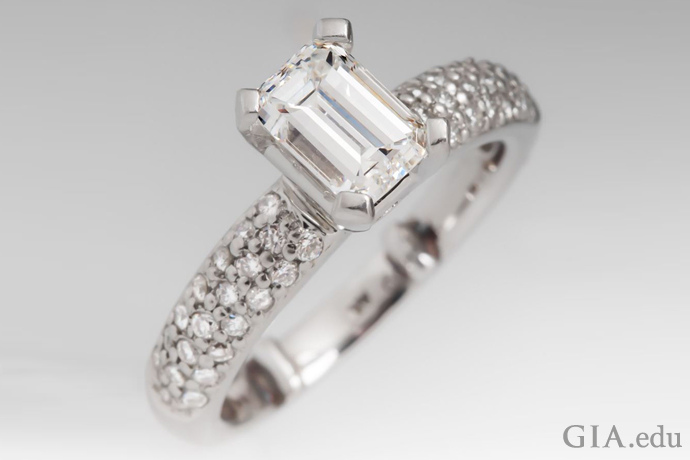
The pavé set diamonds in this engagement ring glitter like stars in the night sky. The center stone is a 1.00 ct emerald cut diamond. Courtesy: EraGem
Bezel setting: In this setting style, a band of metal surrounds the diamond’s girdle. As a result, the diamond’s circumference may appear to be larger. Bezel engagement ring settings also afford extra protection against accidental bangs and bumps.
- TIP: The bezel setting is generally used for round and oval diamonds. It is more difficult to create a bezel setting for other shapes, such as square and marquise diamonds.
- TIP: Like rock climbing? Playing lacrosse? Vigorous exercise? The bezel setting protects the center stone, so it is a great choice for active people.
- TIP: A bezel setting could deaden the brightness of a poorly cut diamond.

This 0.53 ct diamond appears larger because of the bezel setting. Courtesy: 1stdibs.com
Invisible setting: For this technique, small diamonds are cut with grooved pavilions and then slipped into a thin wire framework. This eliminates the need for prongs and allows the gems to be set against each other. The result is that the entire diamond is visible, and groups of diamonds can look like one large gem.
- TIP: There is a drawback. Should a diamond in an invisible setting be damaged, it is extremely difficult to repair or replace it. So Invisible diamond engagement ring settings are probably not a good idea for physically active individuals.
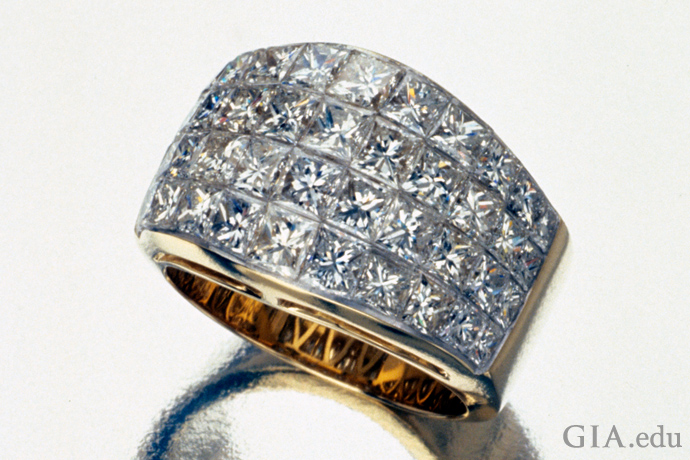
An invisible setting can give the appearance of a field of diamonds. Courtesy: Ambar Diamonds
More Tips to Make Your Diamond Look Bigger
Choose a thin ring shank or band: Here’s a way to trick the eye. A thin band can make a diamond look larger. Similarly, a thick band might overshadow the diamond.

Left photo: A thick band nearly overwhelms the 1.68 ct diamond center stone. Photo: Robert Weldon/GIA. Courtesy: Rogel & Co., Inc. Right photo: What a difference a band makes. The main diamond in this ring rightfully takes center stage. Courtesy: Platinum Guild International
Add side stones to your engagement ring setting: This is a great way to add sparkle and size to an engagement ring – and the options are endless. You could add a diamond baguette on each side of the center stone. You could pick colored stones to create contrast. You could use different colored metals around the side stones.
Unlike the melee used for pavé and halo settings, you may have the opportunity to choose the side stones. If you are uncomfortable making the choice, read our advice on choosing engagement ring side stones to get you started. If you have any questions, ask your jeweler for help, he/she will have a trained eye.
And last, but certainly by no means least: keep your diamond clean. While a clean diamond won’t look bigger, per se, it will display that signature sparkle that telegraphs “diamond” across a crowded room – and isn’t that what it’s all about?
Speaking of diamond sparkle, here are some tips and tricks to get the most sparkle out of your diamond engagement ring.

